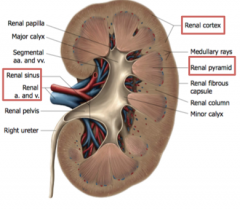![]()
![]()
![]()
Use LEFT and RIGHT arrow keys to navigate between flashcards;
Use UP and DOWN arrow keys to flip the card;
H to show hint;
A reads text to speech;
25 Cards in this Set
- Front
- Back
|
What is an anatomical relationship? |
Being able to describe the relationships between the organ of choice and other structures in the body |
|
|
What are the four components of the urinary system? |
Kidneys Ureters Bladder Urethra |
|
|
What are the functions of the urinary system? |
Filter blood to produce urine Remove urine from body |
|
|
Where in the body are the kidneys located? Where is it in comparison to the vertebral column? |
In the posterior abdominal region, immediately lateral to the vertebral column |
|
|
Which kidney is slightly higher? Why is this so? |
Left is higher due to position of the liver pushing the right kidney downwards |
|
|
What are the 3 regions of the kidney? |
Superior Pole Inferior Pole Renal Hilum |
|
|
What are found superiorly to the kidneys? |
Suprarenal Glands |
|
|
What are found anteriorly to the kidneys? |
Colic flexures (& pancreas posterior to the left kidney) |
|
|
What is found posterior to the kidneys? |
Diaphragm & musculature |
|
|
What is found laterally on the left kidney? What is found inferiorly on the left kidney? |
Laterally: spleen Inferiorly: descending colon & jéjunum |
|
|
What is found anterior-superior to the right kidney? What is found medially to the right kidney? |
Anterior-superior: liver Medially: Duodenum |
|
|
What are the 5 layers of fat/fascia/muscles surround the kidneys? |
Perinephric Fat: surrounds kidneys Renal Fascia: surrounds perinephric fat Paranephric Fat: posterior to renal fascia Peritoneum: anteriorly located Back Musculature: posteriorly located |
|
|
At what level do the kidneys sit in regards to the vertebrae? |
extend from T12 - L3 vertebrae |
|

|

|
|
|
What is present in the renal hilum? |
Renal Vein Renal Artery Ureter |
|
|
What are the ureters & what's their function? |
Tubes of smooth muscle that transport urine to the bladder |
|
|
What are the 3 constriction points where kidney stones can get caught? |
1) Ureteropelvic Junction - exiting kidneys 2) Pelvic Inlet - over common iliac artery 3) Entrence to Bladder - small sphincter |
|
|
What is the structure of the bladder and function? |
Apex: directed towards pubic symphysis Base: faces postero-inferiorly Inferolateral Surface: cradled between legator ahi & obturator internus muscles Neck: intersection of base fixed to pubic bones Function: storage of urine |
|
|
What is the muscle found in the base of the bladder? |
Trigone Muscle |
|
|
What transports urine from the bladder to the outside? |
Urethra |
|
|
What's the difference of the urethra in males & females? |
Females: - short (~5cm) - external opinion anterior to vagina Males: - long (~20) - more complex due to prostatic part (contains prostatic sinuses & ejaculatory ducts) |
|
|
Explain the blood supply & venous drainage of the kidneys. |
Renal artery - branches from abdominal aorta Renal vein - empties into inferior vena cava Left renal artery is higher & shorter Right renal artery is lower & longer |
|
|
Explain the blood supply & venous drainage of the bladder. |
Vesical arteries - superior & inferior - branch off anterior trunk of iliac artery Pelvic Plexus - drains into internal iliac vein |
|
|
Explain the innervation of the ureters. |
Driven by Autonomic Input from Visceral Plexuses in the abdomen Smooth muscle walls with peristaltic waves generated to move urine into bladder (not gravity driven) |
|
|
Explain the innervation of the bladder. |
Arises from the Hypogastric Visceral Plexus Very complex neural process |

